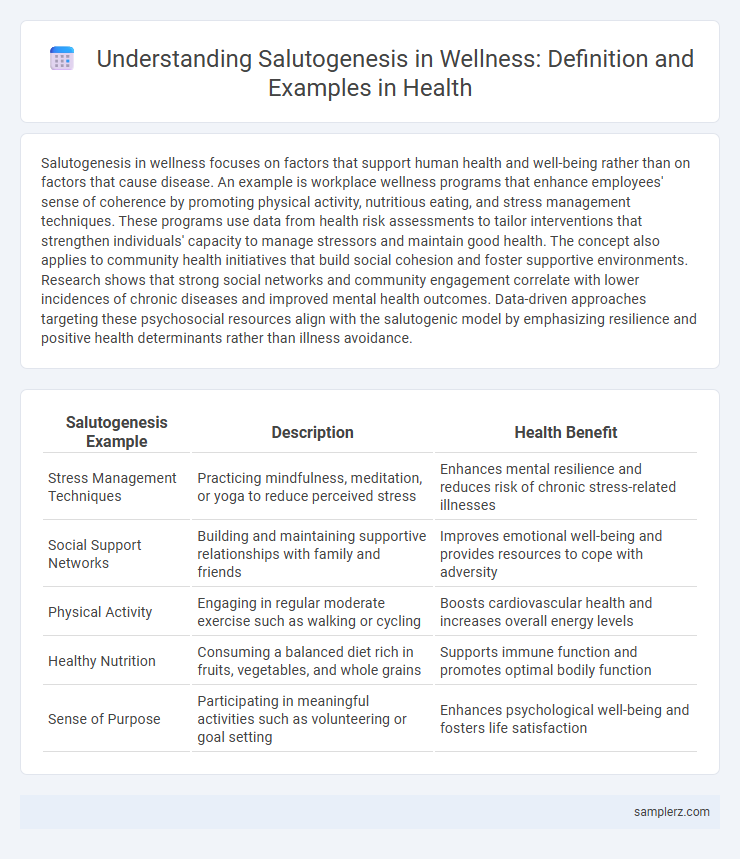Salutogenesis in wellness focuses on factors that support human health and well-being rather than on factors that cause disease. An example is workplace wellness programs that enhance employees' sense of coherence by promoting physical activity, nutritious eating, and stress management techniques. These programs use data from health risk assessments to tailor interventions that strengthen individuals' capacity to manage stressors and maintain good health. The concept also applies to community health initiatives that build social cohesion and foster supportive environments. Research shows that strong social networks and community engagement correlate with lower incidences of chronic diseases and improved mental health outcomes. Data-driven approaches targeting these psychosocial resources align with the salutogenic model by emphasizing resilience and positive health determinants rather than illness avoidance.
Table of Comparison
| Salutogenesis Example | Description | Health Benefit |
|---|---|---|
| Stress Management Techniques | Practicing mindfulness, meditation, or yoga to reduce perceived stress | Enhances mental resilience and reduces risk of chronic stress-related illnesses |
| Social Support Networks | Building and maintaining supportive relationships with family and friends | Improves emotional well-being and provides resources to cope with adversity |
| Physical Activity | Engaging in regular moderate exercise such as walking or cycling | Boosts cardiovascular health and increases overall energy levels |
| Healthy Nutrition | Consuming a balanced diet rich in fruits, vegetables, and whole grains | Supports immune function and promotes optimal bodily function |
| Sense of Purpose | Participating in meaningful activities such as volunteering or goal setting | Enhances psychological well-being and fosters life satisfaction |
Understanding Salutogenesis: A Shift Toward Wellness
Salutogenesis emphasizes the origins of health by focusing on factors that support human well-being, such as a strong sense of coherence and effective stress management techniques. This approach encourages individuals to build resilience through positive lifestyle choices including regular physical activity, balanced nutrition, and social support networks. Emphasizing salutogenesis in wellness promotes proactive health maintenance, reducing the risk of chronic diseases while enhancing mental and emotional stability.
Key Principles of the Salutogenic Model
The salutogenic model emphasizes key principles such as the sense of coherence, which includes comprehensibility, manageability, and meaningfulness, enabling individuals to effectively cope with stress and promote well-being. Health promotion strategies rooted in salutogenesis focus on enhancing resources and resilience rather than merely preventing disease. Incorporating social support, adaptive coping mechanisms, and positive lifestyle choices exemplifies salutogenic approaches in wellness programs.
Promoting Resilience: Salutogenesis in Everyday Life
Promoting resilience through salutogenesis involves fostering protective factors such as social support, effective stress management, and a strong sense of coherence, which enables individuals to perceive life challenges as comprehensible, manageable, and meaningful. Everyday practices like mindfulness, regular physical activity, and maintaining positive relationships contribute to enhancing physical and mental well-being by strengthening adaptive coping mechanisms. These salutogenic approaches shift the focus from disease prevention to health promotion, supporting sustainable wellness in daily life.
Sense of Coherence: Foundation of Salutogenesis
The Sense of Coherence (SOC), composed of comprehensibility, manageability, and meaningfulness, serves as the foundational framework in salutogenesis, promoting resilience and overall wellness. Research shows that individuals with a strong SOC experience better stress management, enhanced immune function, and reduced risk of chronic diseases. Integrating SOC principles into health programs fosters adaptive coping strategies, improving quality of life and long-term health outcomes.
Environments That Foster Wellness: Salutogenic Approaches
Environments that foster wellness through salutogenic approaches prioritize factors that promote health and well-being, such as supportive social networks, access to green spaces, and opportunities for physical activity. These settings enhance individuals' sense of coherence by providing meaningful challenges, comprehensible surroundings, and resources for effective stress management. Integrating design elements that encourage community engagement and resilience contributes to sustainable health improvements and overall quality of life.
Community Wellness Initiatives Rooted in Salutogenesis
Community wellness initiatives rooted in salutogenesis prioritize enhancing health resources and resilience rather than merely preventing disease. Programs like local exercise groups, social support networks, and access to green spaces promote a sense of coherence and empower individuals to manage stress effectively. These initiatives foster connectedness and active participation, crucial factors in maintaining holistic well-being and reducing health disparities.
Mind-Body Practices as Examples of Salutogenic Health
Mind-body practices such as yoga, meditation, and tai chi exemplify salutogenesis by promoting mental resilience and physical well-being through stress reduction and enhanced self-awareness. These practices stimulate the nervous system to balance cortisol levels, reduce inflammation, and improve immune function. Integrating mind-body exercises into daily routines supports a sense of coherence, which is central to salutogenic health models.
Nutrition and Lifestyle Choices in Salutogenic Wellness
Nutrition plays a crucial role in salutogenic wellness by emphasizing nutrient-dense foods that support immune function and reduce inflammation. Lifestyle choices such as regular physical activity, stress management, and adequate sleep enhance the body's resilience and promote overall well-being. Integrating balanced diets rich in antioxidants with mindful habits fosters a positive health orientation, aligning with the core principles of salutogenesis.
Case Studies: Salutogenesis Success Stories in Health
Case studies in health reveal salutogenesis success stories where individuals adopting positive health behaviors, such as regular physical activity and stress management techniques, experience enhanced well-being and resilience against chronic diseases. Research highlights programs integrating salutogenic principles, emphasizing sense of coherence and resource mobilization, resulting in improved mental health outcomes and lower healthcare costs. These examples validate the effectiveness of salutogenesis in promoting holistic wellness and preventive care strategies.
Integrating Salutogenesis into Personal Wellness Plans
Integrating salutogenesis into personal wellness plans emphasizes enhancing factors that support health and well-being, such as fostering a strong sense of coherence through meaningful social connections and stress management techniques. This approach prioritizes identifying resources like resilience-building activities, physical exercise, and mindfulness practices to strengthen an individual's capacity to maintain health. Personal wellness plans grounded in salutogenesis shift the focus from disease prevention to promoting positive health determinants for long-term vitality.

example of salutogenesis in wellness Infographic
 samplerz.com
samplerz.com